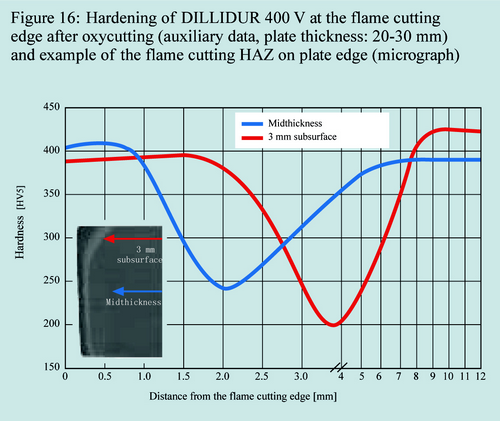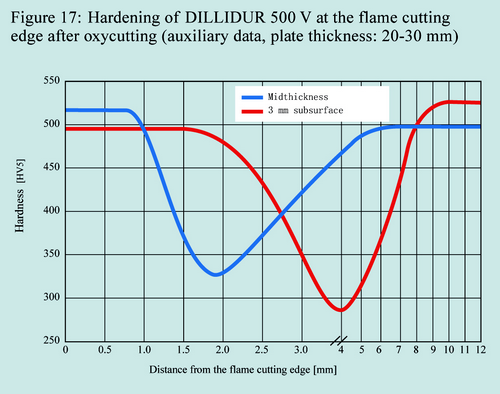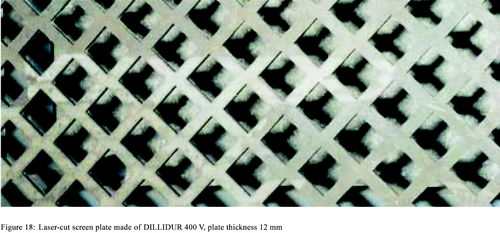Thermal Cutting
Flame cutting, plasma arc cutting or laser cutting of DILLIDUR L and V steels is possible without any difficulty if carried out correctly and as long as appropriate tools in good working condition, suitable for the respective job are available. As different manufacturers have developed a variety of tools, you should note the respective settings and advice prescribed by the manufacturer in the cutting tables (nozzle selection, gas pressure, working methods, speed etc.).
The surface condition of the plates also has a marked influence on the flame cutting conditions and the cut face quality that can be achieved. Where high demands are placed on the cut face quality, it is necessary to clean the top of the work-piece around the cut from scale, rust, paint and any other impurities.
Oxycutting: In this flame cutting method, the steel is heated to inflammation point with a gas and oxygen flame and then burned in a cutting oxygen jet. In this process, only an extremely narrow zone (< 1 mm) next to the cutting edge is heated to hardening temperature (austenized), and because of the extremely high flow of heat into the surrounding cold material, it is transformed into a hardened structure. This heat discharge can reach the cooling speed of quenching in water. The surrounding areas are tempered. We also speak of the so-called heat-affected zone (HAZ).The extreme differences in temperature can lead to stress and, under unfavourable conditions, to hardness cracking. With increasing thickness and alloying content, flame cutting of DILLIDUR steels requires more care than conventional constructional steels.
Flame cutting must be carried out at a temperature high enough to avoid cracking. The cooling speed is thereby reduced so that the austenized zone is not hardened so strongly and the shrinking stress is significantly reduced. The minimum preheating temperatures given in the table 6 have proved to be appropriate for oxyacetylene cutting.
Re-entering angles should be flame cut with a radius, in order to reduce the notch effect.

If the cutting edges are cold formed in further processing, for example by bending, the zone hardened by flame cutting should be removed for all DILLIDUR steels by grinding in the area to be formed (see section "Cold forming",p.20).
For DILLIDUR V steels, the flame cutting edge reaches the hardness of the original water-hardened material again. In between is a small softened zone, which is rather wider near the surface because of the spreading of the heating flame.
DILLIDUR V steels should not be heated above 250 °C for long periods, since they would otherwise lose much of their hardness.
Therefore, for flame cutting parts which are unable to dissipate heat quickly enough such as small components, screen plates, lamellae, cutter blades etc., additional cooling should be provided instead of preheating.
This can be achieved, for example, by flame cutting in a water bath with the plate to be flame cut 2/3 immersed in the water so that the heat can be rapidly dissipated via the water. In this case, the resulting shrinkage force is much smaller, so that there is little risk of cracking because of the narrow heat-affected zone (HAZ). A further advantage is the tighter dimensionional tolerance that can be achieved with this flame cutting method.


Laser and plasma cutting: The major advantages of laser and plasma cutting lie in the higher cutting performance and the narrower heat-affected zone, along with minimum heat input. With both cutting processes it is possible to cut even the smallest parts, lamellae and screen plates with low distortion and without loss of hardness (see Figure 18). With these methods it is also possible to dispense with pre-heating.
A perfect surface of the plates is a fundamental precondition for laser cutting because the laser beam must be concentrated without reflection loss and absorbed without disturbance on the so-called focus on the surface of the plate.
If required, all DILLIDUR steels can be supplied shot-blasted and coated especially for this purpose. The achievable cutting performance depends to a great extent on the laser power and the plate thickness to be cut. With a plate thickness of 10 mm and a laser energy of 2-3 kW, cutting speeds of up to 2000 mm/min are possible.
With suitable surface treatment, e.g. the use of an emulsion, it may even be possible to improve this performance.

Unlike laser cutting, plasma cutting is also suitable for plate thickness above 30 mm. However, the heat affected zone is somewhat wider. Figure 19 shows the typical effect of the different cutting methods on the heat affected zone of a hardened, wear resisting steel.
Water jet cutting: This method is particularly suitable for cutting of DILLIDUR steels because there are no thermal effects which may induce changes in the material and impair the properties of the component. However, the cutting speed is rather slower.

